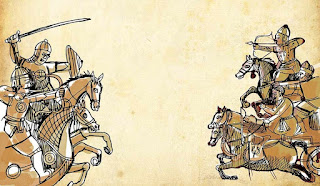Vinaya or Discipline in the Ancient Indian Army
The Essence of Vinaya in Military Contexts
In the ancient Indian military tradition, Vinaya represented more than
obedience; it was about maintaining a high standard of behavior and readiness
under various circumstances. Discipline was critical, especially when soldiers
were encamped or on the move. A disciplined soldier was one who acted in
accordance with a code of conduct that prioritized not just personal conduct
but also respect for fellow warriors and the chain of command.
During
battles, this discipline was mirrored in the soldiers' readiness to regroup and
remain focused despite the chaos around them. The ability to prepare for
reverses—a sudden shift in fortune—was a hallmark of a well-trained army.
Soldiers were groomed to face challenges with mental fortitude rather than mere
physical prowess.
Selection of Leaders and Instructors
One of
the key components of maintaining discipline was the selection of leaders and
instructors. The effectiveness of an army hinged on the qualities of its
leaders, who were often tasked with instilling Vinaya among their troops. Ideal
leaders were characterized by attributes such as wisdom, purity of purpose,
and bravery. Their loyalty to
their cause and troops was paramount. A leader was expected to possess a sharp
intellect and excellent memory, allowing them to strategize effectively in
varied scenarios.
Moreover,
adherence to self-possession and
the study of the shastras
(sacred texts) were considered critical. A well-rounded leader was not just a
fierce warrior but also an intellectual warrior capable of making decisions
based on moral and ethical grounds. Their capacity to reward or penalize
appropriately was seen as essential in maintaining discipline within the ranks.
Characteristics of an Effective Leader
The
qualifications for an effective leader extended beyond mere battlefield acumen.
Leaders had to be energetic, powerful, and skilled in various arts, all while
being free from vices that could impair judgment. Qualities such as foresight, the ability to seize
opportunities, and the capacity to recognize the appropriate time to engage or
withdraw from battle were of immense value.
Additionally,
leaders were expected to remain free from the passions that could cloud
judgment—anger, greed, obstinacy, and fickleness were seen as weaknesses that
could jeopardize an entire campaign. An effective commander was one who could
smile and engage others positively while observing the customs and traditions
taught by elders.
Training as the Foundation of Military Success
Training
in the ancient Indian army was rigorous and continuous, reflecting the
significance of discipline as a military cornerstone. The Mahabharata, one of the great epics of
India, underscores this dedication to training. It describes the Kaurava army
as well-trained in a variety of combat techniques, including fighting on
horses, chariots, and elephants.
Training
comprised daily exercises year-round, with breaks only on designated holidays.
The king’s presence was essential during these training sessions to ensure that
the armies were motivated and well-prepared. Dressed in full military regalia,
the king not only inspected his troops but also demonstrated his commitment to
maintaining a disciplined and ready military force.
Importance of Physical Development and Combat
Skills
Physical
development played a crucial role in shaping disciplined soldiers. The rigorous
training regimen included competitions in both armed and unarmed combat,
reflecting the multifaceted nature of ancient warfare. Military tournaments were common and served as both a display of
strength and a means of honing skills.
Interestingly,
during combat, rules dictated a certain level of honor among warriors; if a warrior
found himself weaponless, he was provided opportunities to acquire another. If
a soldier broke his bow, he could switch to his sword, and this principle
extended to unarmed fighting as well. The ethos of the battlefield was steeped
in a deep sense of discipline that ensured that battles were fought with
respect for both skill and honor.
Conclusion
Vinaya,
or discipline, was far more than a concept in the ancient Indian army; it was
an essential tenet that governed the actions and training of soldiers and
leaders alike. The high standards of conduct demanded of all military personnel
reinforced a sense of duty, loyalty, and respect. The meticulous selection of
leaders, alongside a rigorous and continuous training regimen, created an army
that was not only formidable in battle but also rich in ethical traditions and
values. In this way, the ancient Indian military exemplified how discipline,
trained oversight, and a commitment to self-improvement could forge a path to
success in warfare, making Vinaya a timeless principle of military
effectiveness.
This
comprehensive understanding of military discipline in ancient India not only
highlights the prowess of their forces but also reflects the broader values
that governed society during that era, emphasizing that a disciplined force was
vital not only for warfare but also for the cohesion and integrity of the
state.




Comments
Post a Comment